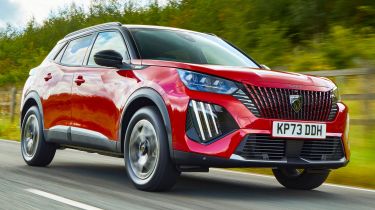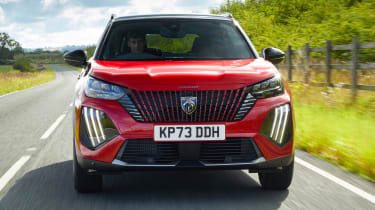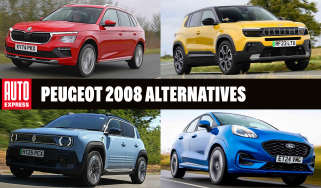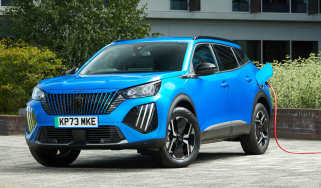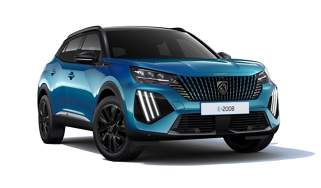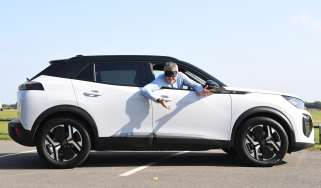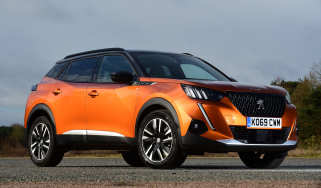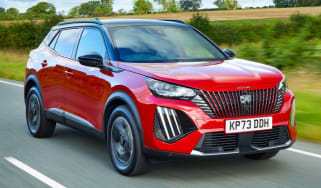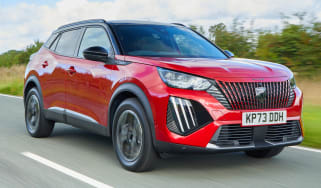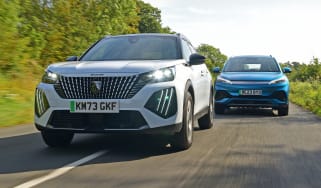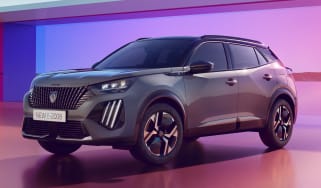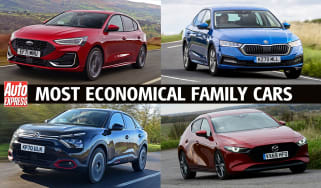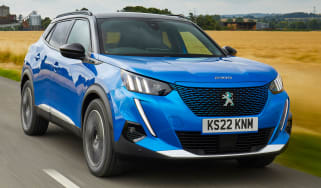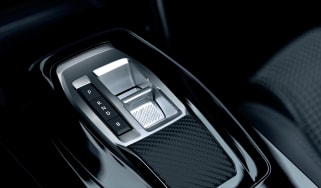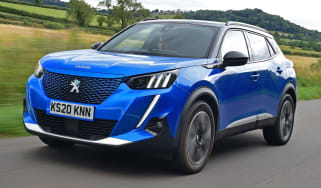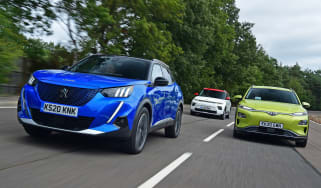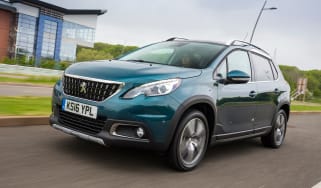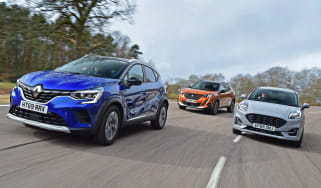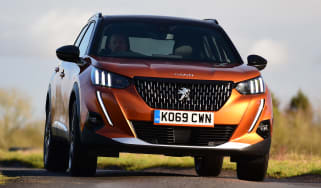Peugeot 2008 review
The Peugeot 2008 is fashionable and well-built, but it feels a little pricey compared to some close rivals

Our opinion on the Peugeot 2008
The Peugeot 2008 stands out in the hotly contested compact crossover and small SUV segment, thanks in no small part to extravagant styling that’s been made even bolder after a facelift. Its eye-catching looks are backed up by a well-built cabin, a decent amount of boot space, and surprisingly refined motorway manners.
Frankly, you could do much worse than the 2008 when choosing from the smorgasbord of small SUVs on offer today. However, some rivals are more fun to drive, while others are more practical. The 2008 is priced against premium competitors, which could be a further sticking point for customers seeking value. It also features Peugeot’s divisive i-Cockpit cabin design, which doesn’t suit everyone.
| Key specs | |
| Fuel type | Petrol, hybrid, electric |
| Body style | Small SUV |
| Powertrain | 1.2-litre, 3cyl, turbo, petrol, front-wheel drive 1.2-litre, 3cyl, turbo, petrol plus 1x e-motor, front-wheel drive 54kWh battery, 1x e-motor, front-wheel drive |
| Safety | 4-star EuroNCAP without safety pack, 5-stars with the safety pack (2019) |
| Warranty | 3yrs/60,000 miles |
About the Peugeot 2008
The Peugeot 2008 is the French firm’s supermini-sized SUV, and starts from £28,500, rising to £31,000 for the hybrid, and £34,500 for the electric model. The range-topping E-2008 in GT Premium trim rounds of the range at just under £39,500, which is rather a lot for a small SUV.
The second generation 2008 arrived to great acclaim in 2019. In the years that followed, the 2008 became one of Peugeot’s best-selling cars, even topping the list of Europe's best-selling crossovers in 2021, before being given a facelift in 2023 that included a new front end incorporating Peugeot's refreshed company logo and latest three-bar lighting signature.
Used - available now
The 2008 is based on the Stellantis group’s CMP small-car platform, which also serves as the base for the Peugeot 208 supermini, along with the Citroën C4 and Citroën C4 X, DS 3, Jeep Avenger, Vauxhall Corsa and Vauxhall Mokka.
The 2008’s engine range isn’t as extensive as some of its rivals, as buyers have a choice of either a 1.2-litre PureTech petrol engine with or without a hybrid system, or the pure-electric Peugeot E-2008. The entry-level 128bhp petrol engine in the 2008 will cover most needs, and it is paired with either a manual gearbox in Allure trim, or an eight-speed automatic with the mid-spec GT or range-topping GT Premium. Meanwhile, the electric E-2008 offers an official range of around 250 miles, and a smoother driving experience than any of the petrol-powered models. If you can’t afford the jump in price between the petrol and electric versions, the hybrid offers lower fuel costs for a smaller financial outlay.
Both petrol and all-electric models are available across the Allure, GT, and GT Premium trim levels. Our preferred version is actually the entry-level Allure because it comes with all the stuff you need without pushing the price up, which is important considering the 2008 costs more to begin with than rivals like the great to drive Ford Puma, the popular Nissan Juke, and practical Volkswagen T-Cross.
Key features of Allure trim:
- 17-inch alloy wheels
- front and rear parking sensors
- 10-inch touchscreen with wireless Apple CarPlay and Android Auto
Key features of GT trim:
- a reversing camera
- full LED headlights
- keyless entry and start
- ambient interior lighting
Key features of GT Premium trim:
- 18-inch alloy wheels
- Heated front seats
- Electric driver’s seat with a massage function
- Wireless smartphone charging
- Adaptive cruise control
- Sat-nav
- Blind spot monitoring
If you're interested in getting yourself a Peugeot 2008, we can help. Configure your ideal Peugeot 2008 now to get top offers from local dealers, check out the latest Peugeot 2008 leasing deals or search for used Peugeot 2008 models with our Find A Car service. You can even sell your existing car for a great price with Auto Express Sell My Car.
Performance & driving experience
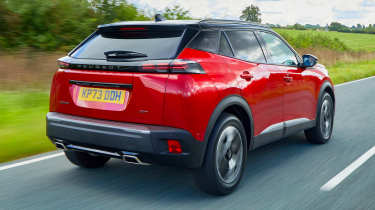
| Pros |
|
| Cons |
|
From the start, you’ll realise that the Peugeot 2008 isn’t the sharpest-handling small SUV. That honour still goes to the Ford Puma, which feels far more rewarding and confidence-inspiring to drive.
All versions of the 2008 and E-2008 are front-wheel drive, which is on par with the class. For those needing the additional traction benefits of four-wheel drive in slippery conditions, you need to look towards something else, like a Toyota Yaris Cross.
Performance, 0-60mph acceleration and top speed
The 128bhp 1.2-litre petrol is our preferred version of 2008, with an acceleration time of 9.7 seconds and a top speed of 122mph. The 1.2 hybrid with 134bhp is currently the quickest 2008 model, with a 0-62mph time of 8.3 seconds, and it can continue up to a top speed of 128mph.
The electric E-2008 has 154bhp model, but its heavy 54kWh battery means it isn’t as quick as the hybrid, requiring 9.1 seconds to reach 62mph. The top speed is 93mph.
Town driving, visibility and parking
Around town, the 2008's light steering makes it a great car for low-speed manoeuvres. We’ve noticed that petrol automatics exhibit a strange vibration through the interior if you try to reverse park while controlling your speed with the brakes.
The ride can be a little fidgety at low speeds, with the Renault Captur offering much better cushioning from potholes and speed bumps
B-road driving and handling
At higher speeds, the 2008 has a decent level of grip to enable you to carry some momentum along a twisty B road. But hit a mid-corner bump, and it can be knocked off your chosen line because the suspension is unable to dampen the initial blow.
Body lean is much more pronounced than in a Puma or an Audi Q2, both of which provide a much more settled driving experience. The electric Peugeot E-2008, with its weighty battery pack mounted low in the car along the floor, does help to counteract the lean of the standard car, although it still isn’t the most agile of its kind to drive.
Weird gear selector shape aside, the auto is great to use, shifting smoothly once on the move. In recent times, Peugeot’s manual gearboxes have been vague and rubbery, but the unit in the 2008 is a significant improvement. It’s still not as joyous to use as the manual gearboxes we’ve used in the Puma or Mazda CX-30, but it does the job.
Motorway driving and long-distance comfort
Hit the motorway, and the fidgety low speed ride settles down. Despite a little door mirror induced wind whistle at 70mph, refinement is impressive overall, with low road noise levels.
| Model | Power | 0-60mph | Top speed |
| 2008 1.2 PureTech 130 | 128bhp | 9.7s | 122mph |
| 2008 1.2 Hybrid 136 e-DSC6 | 134bhp | 8.3s | 128mph |
| E-2008 54kWh 156 | 154bhp | 9.1s | 93mph |
“The E-2008 is a doddle to drive around town, where I like to lean on its progressive regenerative brakes. The set-up isn’t strong enough for one-pedal driving, but it slows the car gently in stop-start traffic and feeds precious energy into the battery.” Richard Ingram, Deputy editor
MPG, emissions & running costs

| Pros |
|
| Cons |
|
The most efficient Peugeot 2008 is the Hybrid 136 version, which returns up to 62.1mpg and emissions as low as 102g/km. That’s followed by the 129bhp petrol model, which in six-speed manual form achieves 52.7mpg and 125g/km, while pairing that engine with the automatic transmission drops the figures to up to 48.9mpg and 133g/km.
The regular PureTech petrol engines compare well with rivals, while the mild-hybrid adds a small electric motor that provides some low-speed electric driving potential, or a short burst of electrical assistance when accelerating to reduce the load on the engine, helping to save fuel and reduce emissions.
| Model | MPG | CO2 | Insurance group |
| 2008 1.2 PureTech 130 Allure | 52.7mpg | 121g/km | 16E |
| 2008 1.2 Hybrid 136 e-DSC6 Allure | 62.1mpg | 102g/km | 23E |
Electric range, battery life and charge time
With the demise of the 50kWh battery version, every E-2008 comes with the larger capacity 54kWh (50.8kWh usable) battery with a maximum range of up 247 miles.
To fully recharge using a standard 7kW AC home wallbox takes just around 7.5 hours, while a 10 to 80 per cent top up charge from a 100kW DC rapid charger takes around 30 minutes.
You can specify a faster 11kW AC charger for £360, but we’re not sure it’ll be worth it considering you���ll need a three-phase electricity supply in order to reach that charging speed, and few UK homes are equipped for that.
| Model | Battery size (usable) | Range | Insurance group |
| E-2008 156 Allure | 54kWh (50.8kWh usable) | 250 miles | 26E |
Insurance groups
The 2008 has slightly higher-than-average insurance group ratings compared with rivals. The least expensive 128bhp Allure petrol sits in group 16 – five groups higher than the base Yaris Cross and six groups higher than the entry-level SEAT Arona.
The hybrid 2008 lands in group 23, while the entry-level E-2008 sits in group 26. In contrast, a 1.0-litre 155 Ford Puma Titanium with 153bhp receives a much lower group 14 rating.
Tax
Rivals with full hybrid power, like the Toyota Yaris Cross and Renault Captur E-Tech, offer higher fuel efficiency and produce less CO2, which means they also have the added benefit of lower Benefit-in-Kind (BIK) company car tax rates. Of course, if you’re interested in a 2008 to run as a company car, the all-electric Peugeot E-2008 may be the one to go for because, like all EVs, it currently attracts a mere three per cent BiK rate.
Fortunately for anyone buying a 2008 or E-2008, no version costs more than £40,000 to purchase when new, and won’t be subject to the luxury car road tax.
Depreciation
Residual values for the petrol and hybrid versions of the second-generation Peugeot 2008 are lagging behind those of its closest rival, the Ford Puma, according to our expert data. After three years and 36,000 miles of ownership, the 2008 is expected to maintain between 45 and 46 per cent of its original value, while the Puma should hold on to between 49 and 55 per cent over the same time period. Neither can quite match the Dacia Duster, which is predicted to hang on to between 58 and 66 per cent of its value.
The all-electric E-2008 is only anticipated to be worth 37 per cent of its original value after three years, however. This is very disappointing compared to the Kia EV3, which should be worth between 45 and 49 per cent of its original value over the same time frame.
To get an accurate valuation for a specific model, check out our free car valuation tool...
Interior, design & technology
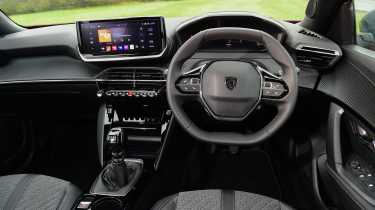
| Pros |
|
| Cons |
|
The latest Peugeot 2008 looks far more distinctive than the somewhat bland-looking original (2013-2019) 2008, with a chiselled shoulder line, blocky silhouette, and distinctive front end dominated by LED lights. A facelift in 2023 has only enhanced its appearance, making it look more like a concept car that someone accidentally let out of Peugeot's vault. It incorporates Peugeot's shield logo, plus the same three-bar lighting signature that also features on the facelifted Peugeot 208 supermini, with the vertical LEDs integrated into gloss-black inserts in the front bumper.
All versions feature a vertical grille pattern in the same colour as the car's bodywork. The 2008’s three-claw LED tail-lights have also been tweaked. There’s no denying that the 2008 is an eye-catching car, which helps it stand out in the bloated small SUV segment.
Interior and dashboard design
Inside, the 2008 interior design, although a little quirky and very gloomy in our opinion, offers superb levels of quality for the class and puts most of its rivals in the shade. Sadly, there aren’t any physical climate controls, so if you want to change the temperature or adjust the fan speed, you’ll have to delve into the central touchscreen. The piano-style keys below the screen only cover limited functions or controls that have to have a physical button by law, such as the hazard warning lights.
Other highlights include Peugeot’s i-Cockpit layout, although you’ll need an Allure and above to get it with the configurable digital dash display. The digital display is similar to Audi’s Virtual Cockpit in that you can change the layout from traditional dials to displaying various trip or driving assistance screens, or – as we’ve found particularly useful – show sat-nav directions on a map. Switching between screens isn’t as easy as in an Audi, and there’s no full map-view option, either.
However, some individuals might find it hard to see the dials, because Peugeot’s i-Cockpit setup also includes a small flat-bottomed steering wheel that you should look over to read the instruments rather than through it. When we tested the 2008, it took us a long time to find a natural-feeling driving position that didn’t involve having the steering wheel basically in our lap, but even then, we couldn’t see the dials fully. The setup won’t suit all, so we’d recommend trying a 2008 first before buying.
What is the interior quality like?
While the striking design and layout of the 2008 interior is what hits you first, once you’re settled you’ll start to notice that many of the areas you frequently come in contact with have a premium feel to them, putting some distance between this Peugeot and the rather disappointing insides of the Volkswagen T-Cross You will still find some cheaper plastics used, but these are in less obvious places, such as the lower door cards and glovebox lid.
Sat-nav, stereo and infotainment
Every 2008 features a 10-inch central touchscreen display with Bluetooth, a DAB radio, plus wireless Android Auto and Apple CarPlay smartphone connectivity to run your own audio and navigation apps. In-built sat-nav is an option on Allure and GT trims, and standard on the GT Premium.
All versions get a screen with high-definition graphics that looks visually appealing, but the operating system is very laggy, often using swipe transitions to cover up the thinking time the car needs when you tap to enter a menu. Ultimately, it’s nowhere near as slick as the setups in rivals such as the Hyundai Kona.
The mid-range GT features a 3D version of the i-Cockpit digital driver display, which looks very modern, but it’s more of a gimmick than a genuinely useful feature. A wireless smartphone charging pad is available as part of the navigation and access pack on Allure trim, the navigation, vision, and drive assist pack on GT, or as standard on the GT Premium trim.
“The high-quality and hard-wearing interior looks as fresh as it did the day the car was delivered more than five months and 5,000 miles ago.” – Richard Ingram, Deputy editor
Boot space & practicality
| Pros |
|
| Cons |
|
One of the key downsides to the Peugeot 2008’s styling is that access to the rear is difficult. The sills are high, so you have to climb in over them and, to compound things, you then find the low roofline requires you to stoop in order to get in – rather annoying for anyone strapping children into car seats, for example. Buyers needing frequent access to the rear seats should consider the Hyundai Kona or Skoda Kamiq.
Front and rear parking sensors are standard on every model, while GT trim provides a reversing camera. A front and rear camera system, and blind spot monitoring to warn you of approaching vehicles along your flanks are both available as part of an optional pack, or as standard on GT Premium trim.
Dimensions and Size
The Peugeot 2008 measures 4,300mm long, 1,770mm wide and 1,550mm tall, making it slightly longer than the Ford Puma (4,207mm), but not quite so wide. The Renault Captur sits between the two, measuring 4,227mm in length.
| Dimensions | |
| Length | 4,300mm |
| Width | 1,770mm (1,987mm inc mirrors) |
| Height | 1,550mm |
| Number of seats | 5 |
| Boot space | 434-1,467 litres |
Driving position, seats & space in the front
If you do manage to find a comfortable driving position (as discussed on the previous page), the 2008 has plenty of head, leg, and shoulder room, although visibility isn’t great, so you’ll be making good use of the standard front and rear parking sensors. Larger individuals may find that the small steering wheel and tiny pedals can make you feel like a gorilla behind the wheel.
Peugeot hasn’t forgotten basic practicalities, though. There’s still a good level of storage, with cubbies, trays and bins dotted around to hold gadgets and various other items. We particularly like the covered smartphone tray, because you can close the lid on your phone to stops you from getting distracted by notifications.
Seats & space in the back
The 2008 doesn’t offer as much room in the back as a Kona or a Kamiq. While it does boast a surprising amount of headroom, legroom isn’t as generous, so it’s not great for ferrying around adults. It’s a shame the 2008 doesn’t feature a sliding rear bench like you get in the Captur, because that would allow rear passengers the option of greater legroom at the expense of some boot space. There’s also a large hump in the floor that eats up rear passenger foot space, so the 2008 is better suited for carrying four people, rather than five.
The 2008 comes as standard with two sets of ISOFIX mounting points – both located on the outer positions of the rear seats.
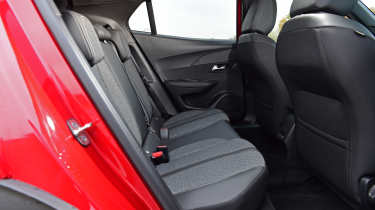
Boot Space
The Peugeot 2008 offers 434 litres of boot space, which is decent, but beaten by the Kona, which offers 466 litres. Folding the 2008’s rear seats gives you a total of 1,467 litres of boot space to play with. With its 456-litre boot, the Ford Puma also trumps the 2008 and includes a hidden storage compartment called the ‘Megabox’.
The Captur has 12 litres less than the 2008, but as we mentioned, its sliding rear bench seat allows owners to prioritise either boot space or passenger room. Utilise this function by sliding the bench all the way forward, and there are 536 litres on offer, which puts the 2008 at a distinct disadvantage once again.
On a more positive note, all versions come with a variable-height boot floor, which reduces the liftover height and removes the awkward step when the rear seats are folded down.
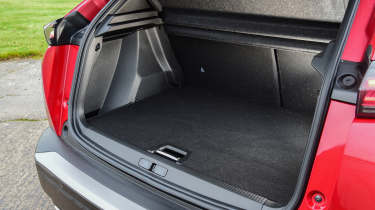
Towing
All PureTech petrol-powered 2008s have a maximum braked trailer weight of 1,200kg, which should be enough to tow a small caravan. The additional weight of the battery, electric motor, and six-speed dual-clutch gearbox of the Hybrid version reduces this version's towing capacity to 1,100kg.
Like many smaller electric vehicles, Peugeot does not quote towing weights for the E-2008. However, the electric Volvo EX30 is rated to tow, and can handle up to 1000kg in single motor, standard range form, or up to 1,600kg with the extended range battery.
“While I no longer have to cart around a bulky buggy or travel cot when we go away, there’s still plenty my daughter wants to pack in – including a small bike (now with pedals), plus plenty of books, Barbies and cuddly bunnies. The 2008 is, honestly, a bit small for a family of three; you can see why so many people gravitate to larger models for daily duties.” – Richard Ingram, Deputy editor
Reliability & safety
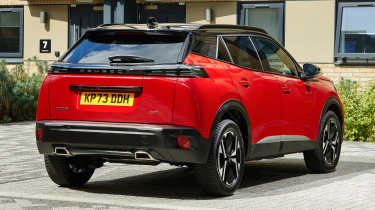
| Pros |
|
| Cons |
|
The Peugeot 2008 didn’t appear on our top 50 best cars to own list in the 2025 Driver Power owner satisfaction survey, but the Peugeot brand has improved upon its 2023 score in the best manufacturer list, placing sixth out of 32 manufacturers in the 2024 survey, behind Korean rival Kia, but ahead of Nissan, Skoda, SEAT, Vauxhall, VW, and Renault.
Euro NCAP tested the overall safety of the second-generation 2008 in 2019 and awarded it a four-star rating for cars without the safety plus pack, and the full five stars when equipped with it. The more advanced autonomous emergency braking (AEB) system that get can spot cars, pedestrians and other vulnerable road users, such as cyclists at night is standard across the range for cars sold in the UK.
Other standard safety kit includes driver attention alert, lane keep assistance, traffic sign recognition, along with front and rear parking sensors. You’ll need to add the £400 blindspot and drive assist pack to a petrol manual 2008 in Allure trim in order to get adaptive cruise control, blindspot warning, and front and rear cameras. That’s a shame because some of those features are standard on rivals like the Volkswagen T-Cross, or Toyota Yaris Cross.
The same assist pack on automatic or electric E-2008 models also in Allure trim costs slightly more at £450, but that does at least include all of what the manual models get, along with a stop and go function to the adaptive cruise control system to help in traffic, and a land positioning assistance system to take some of the stress out of long motorway drives.
In order to get blindspot, adaptive cruise and the surround view camera system on a mid-range GT model, you’ll need to specify the £800 navigation, vision, and drive assist pack. The highest-spec GT Premium model gets all of these safety assistance features as standard.
| Key standard safety features |
| Euro NCAP safety ratings |
|
Buying and owning
Our best buy: Peugeot 2008 1.2 PureTech Allure
While the hybrid version gets the best fuel economy, we think the regular petrol model offers the best value for money. It’s also quick enough for most needs and still compares well with its rivals in terms of running costs. The entry-level Allure trim also comes with all the equipment you’ll need without you needing to fork out for the pricier trim levels.
The Peugeot 2008 comes with a two-year/unlimited mileage factory warranty and an additional year from the dealer, totalling three years or 60,000 miles. That matches the industry standard, but can't match Kia’s seven-year cover and Toyota's ten-year package.
Petrol-powered 2008s need servicing every 12 months or 12,500 miles. The Hybrid version still requires an annual service, but can travel 16,000 miles between visits. It uses a timing chain rather than a timing belt, like the petrol version, which doesn’t require scheduled maintenance. The electric E-2008 requires an initial service after 12 months or 8,000 miles, whichever comes first, followed by every two years or every 16,000 miles thereafter.
Peugeot offers fixed-price servicing packages to help spread the cost of scheduled maintenance, starting with a three-year/30,000-mile policy that costs around £20 per month for petrol cars, or roughly £11 per month for electric ones.
Peugeot 2008 alternatives
The Peugeot 2008 will appeal to those looking for a smart-looking and premium-feeling small SUV that is well-equipped and has a wide range of engine options. The addition of a mild-hybrid version helps provide a more fuel-efficient choice to challenge the full hybrid Honda HR-V, Hyundai Kona, and Toyota Yaris Cross – although the latter is more efficient than the 2008.
There’s also an all-electric model to take on the Hyundai Kona Electric, which will suit company car drivers hoping to keep their tax bills low, and it offers respectable electric range and relatively rapid charging speeds. However, the E-2008 is beaten overall range by our preferred 65kWh version of Kona Electric.
The quirky i-Cockpit interior layout of the 2008 won’t suit everyone, and it’s quite small in the back, which might lead parents towards the more spacious Kona or the versatile Renault Captur. It also isn’t particularly fun to drive, so those coming at this from a regular supermini may want to look at the sharper-handling Ford Puma instead. Those looking for value will be better off with the Dacia Duster, while the Skoda Kamiq is a great all-rounder.
Peugeot 2008 owner reviews
Here is what owners thought of the Peugeot 2008 in the 2024 Driver Power customer satisfaction survey.
| What they like | What they don't like |
| “The 2008 is great value in a very crowded segment. So far, the running costs also seem to be very low.” | “The 50kWh battery is a bit too small for non-local journeys, putting us at the mercy of public chargers.” |
| “It’s my first full EV, and I’d never go back to a petrol or diesel car. My e-2008 is really good to drive.” | “Even with very careful driving, on the verge of hypermiling, I can manage just 190 miles in my e-2008.” |
| “Asking me to name the one thing that I really like about my 2008 is impossible, because I like everything.” | “I’m disappointed with the cabin quality. I’ve needed several spare parts, and they take ages to arrive.” |
| “I used to have Audi and Mercedes autos, which were streets ahead of Peugeot’s. But Peugeot is catching up.” | “The front seats aren’t wide enough, and I only have a small bum! Plus they need more height adjustment.” |
| “The running costs of my e-2008 are very low. 7.5p per kWh equates to around 3p per mile. But the range could be better, and using public chargers pushes up the running costs.” | “The unreliable touchscreen is very disappointing. It often freezes or doesn’t come on at all.” |
| “All-round visibility is very good. I’m impressed with the comfort, and rear-seat legroom is ample even with the driver’s seat well back. But too many settings are hidden in the touchscreen.” | |
| “There are lots of little storage spaces around the cabin, and there’s more boot space than you would probably expect for a small car. But there is no spare wheel, so the boot floor shouldn’t be so high. It cuts the capacity quite noticeably.” | |
| “The ride quality is great; passengers have often said how comfortable my e-2008 is. The handling is also really good, thanks to the low centre of gravity; the steering is sharp and the turning circle is superb.” | |
| “My 2008 feels like a really high-quality car, from the paint finish to the doors that close with a reassuring thunk.” | |
| “It looks better than much more costly SUVs such as Range Rovers. Plus the bright colours look superb.” |
Deals on the Peugeot 2008 and alternatives
Pictures of the Peugeot 2008
Used and nearly new Peugeot 2008
The Peugeot 2008’s timeline starts in 2013, around a year after the Peugeot 208 supermini it’s closely related to first went on sale. Across both generations of Peugeot 2008, the car has offered a blend of sharp styling, agile handling and a comfortable ride. The Peugeot 2008 Mk2 saw the small SUV move further upmarket than its predecessor, which, while giving the car a more premium feel, also made it a pricier buy.
Peugeot 2008 history
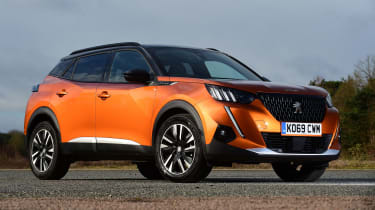
Peugeot 2008 Mk2: 2019-present
The second-generation Peugeot 2008 Mk2 built upon the foundations of its predecessor: practicality and interior build quality were improved, and the looks were more striking this time around. Like the Mk1 model, the Peugeot 2008 Mk2 had close ties to the Peugeot 208, so the two cars featured similar interior tech and features. The powertrain options were similar, too, consisting of petrol and diesel engines (the latter disappeared in 2022 due to poor sales) and – for the first time in a Peugeot 2008 – a pure-electric option.
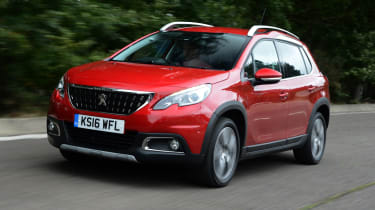
Peugeot 2008 Mk1: 2013-2019
The Peugeot 2008 Mk1 went on sale in 2013 and was billed as the higher-riding equivalent of the Peugeot 208. While the two cars share many parts, the 2008 Mk1 is bigger and more spacious than the 208, and comes with more equipment as standard. Engine options consist of various petrol and diesel engines, and all Peugeot 2008 Mk1s are front-wheel drive. Read our full Mk1 Peugeot 2008 buyer’s guide here…
Peugeot E-2008 long-term test

Our deputy editor, Richard Ingram, was mostly pleased with the Peugeot E-2008’s performance as an efficient runaround, but he couldn’t help but feel that the overall space was rather limited for family duties. The Peugeot’s average real-world efficiency of 4.0mi/kWh is respectable enough for a car of this size, but the lack of any range readout on the dashboard was a consistent cause of frustration. You can read the full long-term test here...
Frequently Asked Questions
The Peugeot 2008 has an eye-catching look, a fine interior and decent amount of tech onboard for the money, plus its PureTech petrol engine is pretty frugal. It’s not quite as roomy in the rear seats as the spacious Skoda Kamiq, however, nor is it very fun to drive.
